David by Donatello
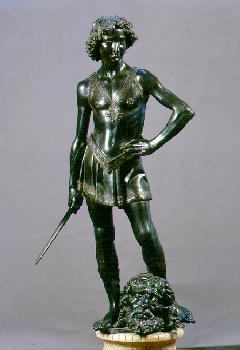
David by Donatello
The David, a bronze statue 158 cm high and 51 cm wide at the base, is the first nude sculpture executed in full relief in the history of art after antiquity. It is undoubtedly the most well known and appreciated work of art by Donatello, but no document or information can provide testimony of its execution. The David was referred to, for the first time, as located at the centre of Palazzo Medici`s courtyard in 1469, on the occasion of the wedding ceremony of Lorenzo il Magnifico to Clarice Orsini. Almost certainly a work of art commissioned by Cosimo il Vecchio meant to adorn that noble spot in the new Medicean Palace (which Michelozzo completed only in 1455), expert art historians have expressed contrasting theories regarding the oeuvre`s chronology placing it from the end of the twenties up to the eve of the artist`s departure to Padova in 1443. This is today considered the most accurate and reliable theory also due to the apparent significant formal similarities which link the David to other works by Donatello dated between the century`s end of the fourth decade and the beginning of the fifth one. As stated by the Director of Bargello National Museum, Beatrice Paolozzi Strozzi: Whatever the underlying meaning the artist and the commissioner wished to convey to the figure, considering the historical circumstances of the time, Donatello here created an absolutely new image of the Bible`s heroic young shepherd and traditional protector of the Florentine Republic. An ephebic adolescent, whose unripe nudity symbolically hints at humility and courage defeating arrogance and brutal force". This melancholy and pensive figure executed by Donatello in a classical way followed the late Hellenistic style particularly noticeable in its details which reveal a subtle sensuality. The "contamination" of the biblical and public subject matter with ancient mythology is quite remarkable in the extraordinary broad brimmed hat, decorated with ribbons and tassels. The laurel symbolizes victory overshadowing David`s face conveying a mysterious quality to his expression which stylistically reminds us of Mercurio`s Pegasus. When the Medici`s were expelled from Florence in 1494, the David statue was confiscated by the Signo-ria and placed as a public heroic figure in the main courtyard of Palazzo Vecchio. Later it was moved to the second courtyard and in the sixteen hundreds it was taken to the Palazzo Pitti. In 1777 it was again moved to the Uffizi Gallery and finally in 1865 it found its last destination at the Bargello National Muse-m where it is visible today. ... from The restoration site of the David by Donatello ( Ministero per i Beni e le Attivita` Culturali )
Our most requested apartments in the Florence historical centre:
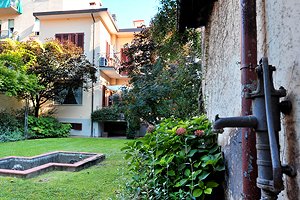 Holiday apartments in pretty villa on the southern outskirts of Florence, in the vicinity of Piazzale Michelangelo. Accommodation for groups of 4/6/8/10/12 people. Air conditioning, Internet connection. Just a few minutes from Florence historical centre.
More details
Holiday apartments in pretty villa on the southern outskirts of Florence, in the vicinity of Piazzale Michelangelo. Accommodation for groups of 4/6/8/10/12 people. Air conditioning, Internet connection. Just a few minutes from Florence historical centre.
More details
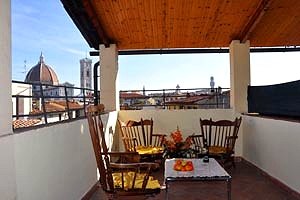 Beautiful apartment sleeping 6+2 in Florence historic centre, at a stone`s throw from Santa Maria Novella railway station. Air conditioning, Internet connection and panoramic balcony with view over the Duomo and the Medici Chapels.
More details
Beautiful apartment sleeping 6+2 in Florence historic centre, at a stone`s throw from Santa Maria Novella railway station. Air conditioning, Internet connection and panoramic balcony with view over the Duomo and the Medici Chapels.
More details
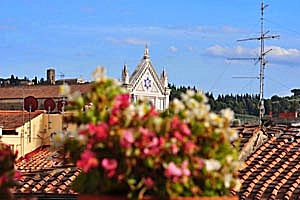 Apartment sleeping 2+1 in the heart of Florence historic centre, in the district of Santa Croce. Panoramic balcony with view over the basilica of Santa Croce, air conditioning, Internet connection, close to the most important Florentine monuments.
More details
Apartment sleeping 2+1 in the heart of Florence historic centre, in the district of Santa Croce. Panoramic balcony with view over the basilica of Santa Croce, air conditioning, Internet connection, close to the most important Florentine monuments.
More details
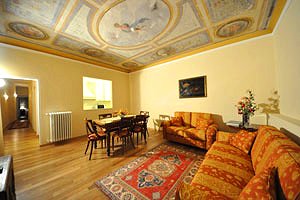 Apartment in the historical centre of Florence a few steps away from the Accademia Gallery. Nearby Piazza Duomo, Piazza Signoria, the Uffizi Gallery . 5+2 beds, Internet Connection and air conditioning.
More details
Apartment in the historical centre of Florence a few steps away from the Accademia Gallery. Nearby Piazza Duomo, Piazza Signoria, the Uffizi Gallery . 5+2 beds, Internet Connection and air conditioning.
More details

 Holiday apartments in pretty villa on the southern outskirts of Florence, in the vicinity of Piazzale Michelangelo. Accommodation for groups of 4/6/8/10/12 people. Air conditioning, Internet connection. Just a few minutes from Florence historical centre.
More details
Holiday apartments in pretty villa on the southern outskirts of Florence, in the vicinity of Piazzale Michelangelo. Accommodation for groups of 4/6/8/10/12 people. Air conditioning, Internet connection. Just a few minutes from Florence historical centre.
More details
 Beautiful apartment sleeping 6+2 in Florence historic centre, at a stone`s throw from Santa Maria Novella railway station. Air conditioning, Internet connection and panoramic balcony with view over the Duomo and the Medici Chapels.
More details
Beautiful apartment sleeping 6+2 in Florence historic centre, at a stone`s throw from Santa Maria Novella railway station. Air conditioning, Internet connection and panoramic balcony with view over the Duomo and the Medici Chapels.
More details
 Apartment sleeping 2+1 in the heart of Florence historic centre, in the district of Santa Croce. Panoramic balcony with view over the basilica of Santa Croce, air conditioning, Internet connection, close to the most important Florentine monuments.
More details
Apartment sleeping 2+1 in the heart of Florence historic centre, in the district of Santa Croce. Panoramic balcony with view over the basilica of Santa Croce, air conditioning, Internet connection, close to the most important Florentine monuments.
More details
 Apartment in the historical centre of Florence a few steps away from the Accademia Gallery. Nearby Piazza Duomo, Piazza Signoria, the Uffizi Gallery . 5+2 beds, Internet Connection and air conditioning.
More details
Apartment in the historical centre of Florence a few steps away from the Accademia Gallery. Nearby Piazza Duomo, Piazza Signoria, the Uffizi Gallery . 5+2 beds, Internet Connection and air conditioning.
More details







